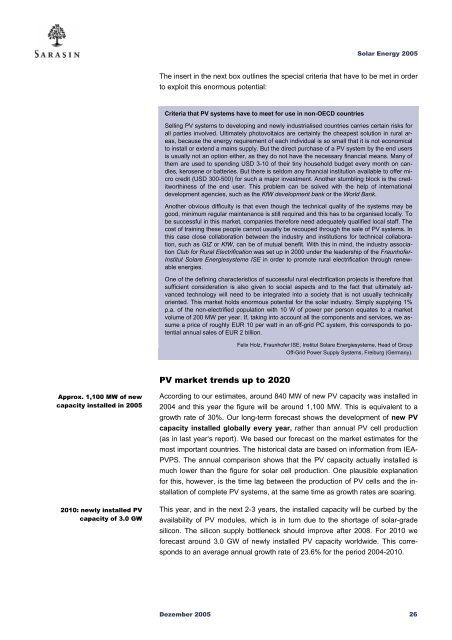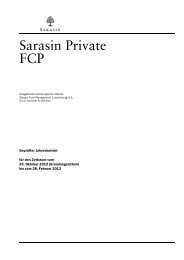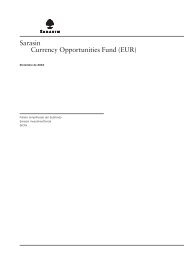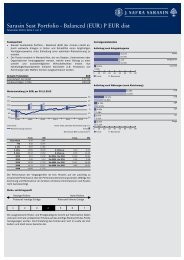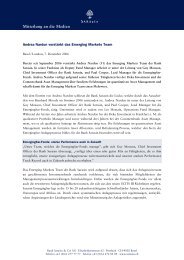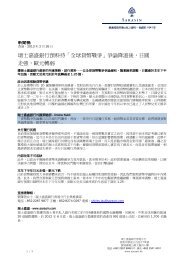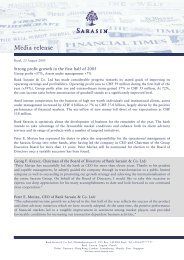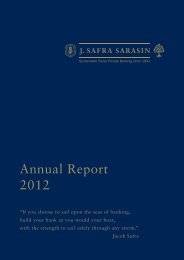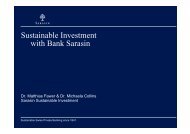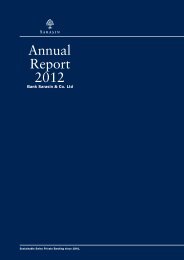Sustainability Report - Bank Sarasin-Alpen
Sustainability Report - Bank Sarasin-Alpen
Sustainability Report - Bank Sarasin-Alpen
Create successful ePaper yourself
Turn your PDF publications into a flip-book with our unique Google optimized e-Paper software.
Solar Energy 2005<br />
The insert in the next box outlines the special criteria that have to be met in order<br />
to exploit this enormous potential:<br />
Criteria that PV systems have to meet for use in non-OECD countries<br />
Selling PV systems to developing and newly industrialised countries carries certain risks for<br />
all parties involved. Ultimately photovoltaics are certainly the cheapest solution in rural areas,<br />
because the energy requirement of each individual is so small that it is not economical<br />
to install or extend a mains supply. But the direct purchase of a PV system by the end users<br />
is usually not an option either, as they do not have the necessary financial means. Many of<br />
them are used to spending USD 3-10 of their tiny household budget every month on candles,<br />
kerosene or batteries. But there is seldom any financial institution available to offer micro<br />
credit (USD 300-500) for such a major investment. Another stumbling block is the creditworthiness<br />
of the end user. This problem can be solved with the help of international<br />
development agencies, such as the KfW development bank or the World <strong>Bank</strong>.<br />
Another obvious difficulty is that even though the technical quality of the systems may be<br />
good, minimum regular maintenance is still required and this has to be organised locally. To<br />
be successful in this market, companies therefore need adequately qualified local staff. The<br />
cost of training these people cannot usually be recouped through the sale of PV systems. In<br />
this case close collaboration between the industry and institutions for technical collaboration,<br />
such as GtZ or KfW, can be of mutual benefit. With this in mind, the industry association<br />
Club for Rural Electrification was set up in 2000 under the leadership of the Fraunhofer-<br />
Institut Solare Energiesysteme ISE in order to promote rural electrification through renewable<br />
energies.<br />
One of the defining characteristics of successful rural electrification projects is therefore that<br />
sufficient consideration is also given to social aspects and to the fact that ultimately advanced<br />
technology will need to be integrated into a society that is not usually technically<br />
oriented. This market holds enormous potential for the solar industry. Simply supplying 1%<br />
p.a. of the non-electrified population with 10 W of power per person equates to a market<br />
volume of 200 MW per year. If, taking into account all the components and services, we assume<br />
a price of roughly EUR 10 per watt in an off-grid PC system, this corresponds to potential<br />
annual sales of EUR 2 billion.<br />
Felix Holz, Fraunhofer ISE, Institut Solare Energiesysteme, Head of Group<br />
Off-Grid Power Supply Systems, Freiburg (Germany).<br />
PV market trends up to 2020<br />
Approx. 1,100 MW of new<br />
capacity installed in 2005<br />
2010: newly installed PV<br />
capacity of 3.0 GW<br />
According to our estimates, around 840 MW of new PV capacity was installed in<br />
2004 and this year the figure will be around 1,100 MW. This is equivalent to a<br />
growth rate of 30%. Our long-term forecast shows the development of new PV<br />
capacity installed globally every year, rather than annual PV cell production<br />
(as in last year‘s report). We based our forecast on the market estimates for the<br />
most important countries. The historical data are based on information from IEA-<br />
PVPS. The annual comparison shows that the PV capacity actually installed is<br />
much lower than the figure for solar cell production. One plausible explanation<br />
for this, however, is the time lag between the production of PV cells and the installation<br />
of complete PV systems, at the same time as growth rates are soaring.<br />
This year, and in the next 2-3 years, the installed capacity will be curbed by the<br />
availability of PV modules, which is in turn due to the shortage of solar-grade<br />
silicon. The silicon supply bottleneck should improve after 2008. For 2010 we<br />
forecast around 3.0 GW of newly installed PV capacity worldwide. This corresponds<br />
to an average annual growth rate of 23.6% for the period 2004-2010.<br />
Dezember 2005 26


